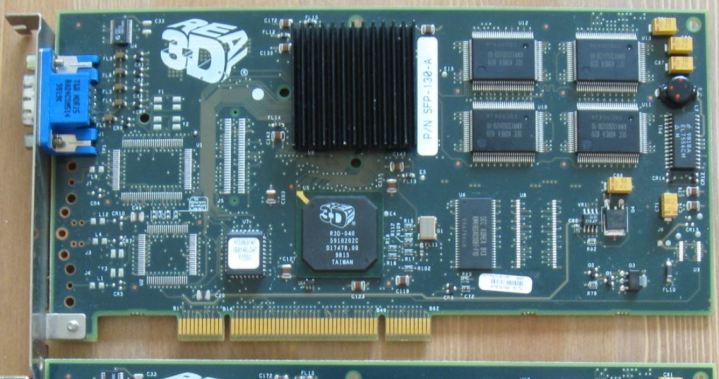ENBLE ranks the worst GPUs of all time loud, disappointing, innovative.
ENBLE ranks the worst GPUs of all time loud, disappointing, innovative.
The Worst GPUs of All Time: A Journey Through the Failures and Missteps in Graphics Card History
 Vintage3D
Vintage3D
When it comes to graphics cards, Nvidia and AMD are currently dominating the market, but they weren’t always the only players in the GPU game. Throughout history, there have been a few brands that have made some serious blunders in the world of graphics cards. In this article, we will take a trip down memory lane and explore some of the worst GPUs of all time. But don’t worry, even though these cards were failures, each had something interesting or innovative to bring to the table.
The Intel740: A Lackluster Attempt
In the late 1990s, when the PC gaming market was booming with 3D titles like Doom, Quake, and Tomb Raider, Intel decided to jump into the 3D graphics acceleration game. The Intel740, also known as i740, was Intel’s first venture into discrete GPUs, and it didn’t quite hit the mark.
The Intel740, released in early 1998, featured a 350nm GPU with 2-8MB of VRAM and utilized the AGP interface, a promising alternative to the then-prevailing PCI. But the AGP interface, although innovative, proved to be a hindrance. It caused CPU performance to suffer as the GPU stuffed the main RAM with textures, impacting both the GPU and the overall system performance.
To make matters worse, the Intel740 struggled to handle 3D graphics efficiently, often delivering artifacts and low visual clarity. This poor performance quickly gained a bad reputation, causing gaming enthusiasts to steer clear of the i740. Despite Intel’s attempts to target pre-built PC manufacturers, the i740 was soon forgotten.
Although the Intel740 was a setback for Intel in the graphics market, the company found success in integrated graphics and moved away from discrete GPUs for the years to come.
The S3 ViRGE: A 3D Decelerator
S3 was another company that tried to capitalize on the 3D graphics boom in the early-to-mid 1990s. The S3 ViRGE was marketed as the “world’s first integrated 3D graphics accelerator,” but it ended up being known as a “3D decelerator” instead.
The ViRGE, launched as one of the first mainstream chipsets supporting both 2D and 3D graphics, failed to impress when it came to 3D rendering. While it performed reasonably well in simple 3D tasks, such as basic rendering, it struggled with more complex tasks like bilinear filtering. In fact, users would often turn off the 3D acceleration and rely on the CPU for graphics processing, rendering the ViRGE’s 3D capabilities useless.
S3 attempted to rectify the situation with later GPU releases, but fierce competition from Nvidia, ATI (later acquired by AMD), and 3dfx prevented them from regaining their footing in the 3D market. Eventually, S3 shifted its focus to midrange segment chips and faded from the limelight.
The Nvidia GeForceFX 5800: The Dustbuster Debacle
 Anandtech
Anandtech
Nvidia, a market leader at the time, had big plans for its GeForce FX series, aiming to make a significant transition into the DirectX 9 era. However, the GeForce FX 5800 Ultra, the flagship GPU of the series, didn’t quite live up to expectations and earned itself the nickname “Dustbuster” among consumers.
On paper, the FX 5800 Ultra seemed impressive, with a 500MHz clock speed, 128MB GDDR2 memory, and the CineFX architecture for enhanced cinematic rendering. But in reality, it struggled with DirectX 9 titles, while ATI’s Radeon 9700 Pro, with its better performance, provided a tempting alternative.
One of the main issues with the FX 5800 Ultra was its innovative cooling solution called the FX Flow. While designed to keep the GPU cool during heavy gaming, the high-speed fan that powered it created an unbearably loud noise. Nvidia’s partners quickly reverted to traditional cooling methods with subsequent GPU releases, leaving the Dustbuster behind.
The 3dfx Voodoo Rush: A Rush to Failure
3dfx was once a formidable rival to Nvidia and ATI, rising to fame in the early 1990s. The Voodoo Rush, a follow-up to 3dfx’s first product, the Voodoo1, aimed to integrate 2D and 3D acceleration into a single card. But this ambitious endeavor resulted in a GPU that couldn’t live up to its promises.
The Voodoo Rush offered 6MB of EDO DRAM, a core clock speed of around 50MHz, and support for popular APIs like Glide, Direct3D, and OpenGL. However, the architecture had compatibility issues, heat problems, and performance that often fell short of its predecessor, the Voodoo 1. Consequently, the GPU faced widespread criticism and quickly lost favor among reviewers and users alike.
While the Voodoo Rush wasn’t solely responsible for 3dfx’s decline, it was an example of the company’s unsuccessful attempts to penetrate the mainstream market. Eventually, Nvidia stepped in and acquired most of 3dfx’s assets, leading to the company’s eventual demise.
Learning from the Failures and Moving Forward
As we look back at the worst GPUs of all time, it’s important to remember that even the biggest companies and most experienced players can stumble. These failures highlight the ever-evolving nature of the graphics card market, where innovation, performance, and user satisfaction are key.
In the current landscape dominated by Nvidia and AMD, it’s unlikely that we’ll see such major missteps again. But let’s appreciate the journey that brought us to this point and be grateful for the lessons learned from these past failures.
So, the next time you open your computer and admire the power of your modern graphics card, take a moment to remember the missteps and blunders that shaped the GPU landscape we know today.
This article originally appeared on Digital Trends.





